Guest Blog: Director and Co-composer An-Ting Chang On AUGMENTED CHINATOWN 2.0
The new app takes you on an immersive tour of Chinatown

I first heard the artist Donald Shek talking about the hidden stories of Chinatown alongside his augmented reality images on an app during the CAN Festival 2019 - and I was absolutely fascinated. In my head, I started to imagine introducing theatre into the app. I loved the idea of making Chinatown a stage, bringing sound and more augmented reality to the stories that Donald was telling.
I talked to Donald about this idea and he told me that he had never done anything like that before - but he thought he could give it a try. Artists are people who make non-existing things happen. We decided we needed to work with a writer and brought Joel Tan on board. From that point on, Augmented Chinatown 2.0 started to take shape around the table in the Chinese Arts Now office.
In the process of creating the app, we got to know Chinatown in depth. The more we explored it, the more fascinating we found it. Above the typical Chinese restaurants, there are bars, májiàng games, karaoke, churches and all different sorts of things happening upstairs. When we looked at the buildings in detail, we saw facades in all different styles: elaborate Baroque, neo-Gothic and Victorian. Blue plaques celebrated different kinds of residents from across the years, including the poet John Dryden, jazz musician Ronnie Scott and the Beatles, who had their photos taken in Rupert Court long before they became known worldwide.
All of this showed us how much more complex Chinatown is than people often think. And we want to share its layers of stories with people. Joel set to work on a script for the tour and texts for five miniature dramas.

Creating a theatre piece for a phone is an intriguing experience, so different to live theatre. Apart from when we rehearsed with the actors and recorded the dramas in the studio, everything else was done on a computer. Donald developed all the coding skills needed to realise our ideas about how sound and AR images can be combined together, using specialist software called Unity. It also incorporated the elements of interactivity needed to make it a multi-layered individual experience for the users.
When we put the final production together and had a dry run, effectively a dress rehearsal, on our phones onsite, we realised that managing user experience (UX) on the phone needs a completely different skillset to doing it live. At this point, we got an experienced UI (User Interface) designer, Rich Brown, on board, and the latest version of Augmented Chinatown 2.0, with a new interface, launches on 15 September.
It might have been a different process, and we might be using a different medium, but we have still created a theatrical experience, an immersive one, an app play, which people can experience it on their own phones walking around Chinatown (or remotely at their home).
Is Augmented Chinatown 2.0 a new kind of theatre, one designed exclusively for the phone, one where there are no consumables. All of Chinatown is our stage where we can share with anyone our multilayered plays and a new perspective on the area.
From 15 September, Augmented Chinatown 2.0 is available via the Apple Store and Google Play
Comments

Videos

